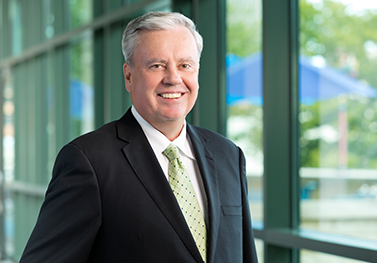Breaking Ground
By MS '71 and William Considine

As Congressional leaders spent much of the year debating various options for repealing and replacing the Affordable Care Act, we have heard about premiums and deductibles, CBO scores, the federal deficit, tax cuts, funding caps, the fate of the individual mandate, and pre-existing conditions. But one word that has barely been mentioned in the health care discussion is this one: children.
The number one insurer for pediatric health care in this country is Medicaid, which was established in 1965 with a focus on children. Since then, Medicaid has been expanded to cover nursing homes, and low-income or disabled adults not yet qualified for Medicare. This has resulted in children being crowded out of Medicaid. Currently, 45 percent of all Medicaid recipients are children, yet they account for just 19 percent of total Medicaid expenditures.
In our state of Ohio, we have 2.4 million children and 1.3 million depend on Medicaid for their health care, but only represent nearly 20 percent of the Medicaid budget.
Children don’t vote. They are not Republican or Democrat. They don’t have a lobby. We must speak up for them. Decisions being made now will impact a generation of children, and we cannot afford to shortchange their futures or the future of our country.
With nearly half of all U.S. children on Medicaid, we need to move beyond the funding uncertainty. Parents who heroically care for children with cancer, diabetes, cerebral palsy, and other chronic illnesses should not have to worry about the political whims of lawmakers casting votes based on campaign promises and re-election strategies.
It is time to spin children off of Medicaid and the Children’s Health Insurance Program (CHIP) and give them their own health care program. As I envision it, such a program would cover 40 million children and could be budget neutral. Individual states would be incentivized to structurally separate Medicaid funding for kids from the remainder of Medicaid funding, thus allowing elected officials to make deliberate and specific decisions related to society’s commitment to children’s health care.
Ohio, with its strong network of children’s hospitals, would be a great place to pilot this concept. Children’s hospitals in Ohio have been working together for years on quality improvement programs that have saved millions of dollars; and our primary care offices, child safety programs and advocacy efforts are keeping kids healthy and out of the hospital.
But no parent plans for a premature delivery, a chronic illness or a traumatic injury, so a safety net program will always be needed. It should be viewed not as welfare, but an investment.
A 2015 Yale study quantified the positive return on investment seen for children covered by Medicaid. The study concluded, “People who had been eligible for Medicaid as children, as a group earned higher wages and paid higher federal taxes than their peers who were not eligible for the federal state health insurance program.”
I have watched the health care debate for 40 years, and the partisan divide shows no sign of improving. Our children and families deserve better.
Children don’t vote. They are not Republican or Democrat. They don’t have a lobby. We must speak up for them. Decisions being made now will impact a generation of children, and we cannot afford to shortchange their futures or the future of our country.
About The Ohio State University College of Public Health
The Ohio State University College of Public Health is a leader in educating students, creating new knowledge through research, and improving the livelihoods and well-being of people in Ohio and beyond. The College's divisions include biostatistics, environmental health sciences, epidemiology, health behavior and health promotion, and health services management and policy. It is ranked 22nd among all colleges and programs of public health in the nation, and first in Ohio, by U.S. News and World Report. Its specialty programs are also considered among the best in the country. The MHA program is ranked 5th and the health policy and management specialty is ranked 21st.